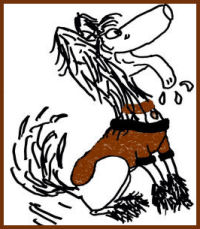Heat stroke is an emergency and requires immediate treatment...
that applies to DOGS too!
Because dogs do not sweat (except to a minor degree through their foot pads) ....SO... they do not tolerate high environmental temperatures as well as humans do. Dogs depend on panting to exchange warm air for cool air. But when air temperature is close to body temperature, cooling by panting is not an efficient process.
Heat stroke begins with
- Heavy panting and difficulty breathing.
- The tongue and mucous membranes appear bright red.
- The saliva is thick and tenacious, and the dog often vomits.
- The rectal temperature rises to 104° to 110°F (40° to 43.3°C).
- The dog becomes progressively unsteady and passes bloody diarrhea.
- As shocksets in, the lips and mucous membranes turn gray. Collapse, seizures, coma, and death rapidly ensue.
Treatment: Emergency measures to cool the dog must begin at once.
- Move the dog out of the source of heat, preferably into an air-conditioned building.
- Take his rectal temperature every 10 minutes.
- Mild cases may be resolved by moving the dog into a cool environment. If the rectal temperature is above 104°F,
- begin rapid cooling by spraying the dog with a garden hose or immersing him in a tub of cool water (not ice water) for up to two minutes.
- Alternatively, place the wet dog in front of an electric fan.
- Cool packs applied to the groin area may be helpful, as well as wiping his paws off with cool water.
- Monitor his rectal temperature and continue the cooling process until the rectal temperature falls below 103°F (39°C).
- At this point, stop the cooling process and dry the dog. Further cooling may induce hypothermia and shock.
-
Following an episode of heat stroke, take your dog to a veterinarian as soon as possible!
http://pets.webmd.com/dogs/heat-stroke-dehydration-dogs |




